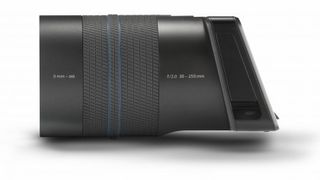Why you can trust TechRadar
At 86 x 145 x 166mm the Illum is quite bulky and not unlike a large, angular bridge camera. Its magnesium and aluminium shell, covered in a silky-feeling finish, gives it a high quality feel. There's a good sized grip on the front, which is reasonably comfortable in the hand, but there's no thumbgrip on the back which is a little unnerving. I found that my thumb regularly pressed the buttons on the rear of the camera when I picked the camera up or when I held it between shots. This can result in settings changes if the camera is turned on at the time, so you either need to turn it off or carry it by the supplied strap.
The large lens has broad zoom and focus rings with a textured latex coating. Neither offers much resistance when they are rotated and they don't have end points, so it's possible to keep rotating even once the maximum focal length or furthest focus point has been reached.

Lytro has given the Illum a pretty intuitive control system, with the majority of features being accessed via the touchscreen. On the far right of the screen is a menu bar, which can be scrolled up and down with an upward or downward swipe of a finger. Tapping on some icons such as the histogram activates that feature but others, like the exposure mode, are marked with a small arrow and tapping them reveals the options available for selection.
Key settings, including sensitivity, shutter speed, white balance and exposure compensation are shown along the bottom of the screen. By default, tapping on the shutter speed or sensitivity brings up a scrollable display at the centre of the screen. This can be navigated by swiping with your finger until you find the option that you want. Alternatively, the front dial at the top of the finger grip can be used to adjust shutter speed in sensitivity or manual exposure mode while the rear dial, within easy reach of the thumb, adjusts exposure compensation in the semi-automatic modes.
Alongside the menu bar is a coloured depth scale. This indicates areas that are within the refocus range of the camera, which is a depth roughly equivalent to shooting at f/16 with a normal camera. Areas that are in front of the focus point, but that can be made sharp in the living image are indicated in blue while those that are behind and also within the refocus zone are red/orange. These areas can be indicated using a depth map on the live view image by pressing the 'Lytro' button on the camera's top-plate. When this is activated image elements that are with the refocus range are edged in blue or red depending upon which side of the focus point they are.
A histogram also shows the number of pixels that are at each distance. As the focus point is moved, the position of the refocus range shifts. The best living images are produced when the peaks of the distance histogram are spread out across the whole refocus range.
Helpfully, there's a button marked with the infinity symbol which focuses the lens at the hyperfocal distance – the optimal point that ensures maximum depth of field.
Although it's not a high-resolution device, the Illum's screen provides a pretty good view in most situations and doesn't suffer excessively from reflections. It's also responsive to touch and the icons and menu screens are clear.
Living images, those that can be refocused, can be seen on the back of the camera. Tapping on any part of the image on the screen refocuses the image at that point. You tap again to refocus elsewhere. It's also possible to view and refocus living images on a computer screen using the supplied Lytro Desktop software, which allows 4Mp two dimensional JPEG versions of the image to be saved.
The Illum has Wi-Fi connectivity built-in and it's easy to connect the camera to a smart device like an iPhone. Once this connection has been made it possible to browse images that are stored on the camera's SD card and upload them to your galleries on Lytro's website. It's also possible to share images from the website on Facebook, Twitter, Google+ and Pinterest or send links to them via email or SMS.
Lytro plans to allow the camera to be controlled remotely via the app at some point in the future, but this functionality is not currently available.
Living images may also be shared via a Lytro account and it's possible to copy a string of code to embed files within a website. Alternatively, living images can be used to create videos that show the shift in focus and these can be saved in MP4 format for easy sharing.
Current page: Build and handling
Prev Page Introduction and features Next Page Performance and Verdict
